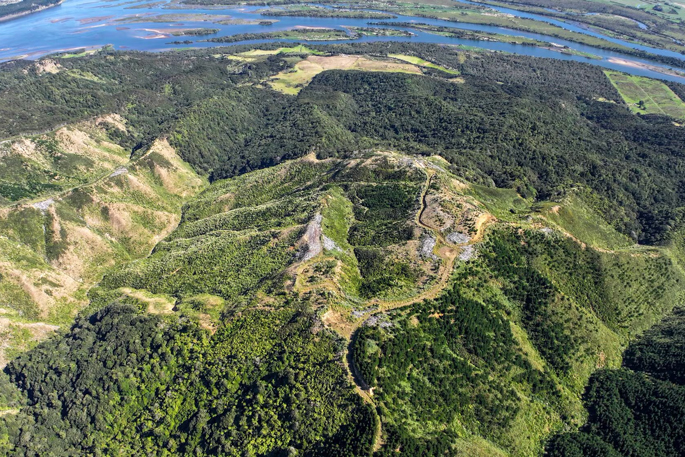A construction industry crash in China is sending shockwaves through the timber trade here.
“There’s elephants in the forest,” said Rotorua-based forestry consultant Jeff Tombleson.
China was by far the largest importer of New Zealand logs – 92% in the year to June last year.
But Tombleson said it had been “throttling back” on the quantity taken since China’s property market started contracting in 2021.
Mega-infrastructure projects there such as new cities, ports and railways were nearing completion, he said.
He said most of the New Zealand timber exported to China was used on construction sites for concrete-casting (boxing), a technique used in 60% of the country’s multi-storey builds.
Since 2019, New Zealand’s isolating export log prices have occasionally “come back” to sub-$100 per cubic metre from an average of $132.
At the lower level, he said harvesting for most of the small forests’ estate was not viable and because there was little or no domestic demand, they shut their gates.
In his 50-year forestry career he has not witnessed such a “negative outlook” for the industry.
A Ministry of Foreign Affairs and Trade report released in December said property investment in China fell 10.2 per cent in the first seven months of 2024.
October data showed an improvement in housing sentiment. However, the overall picture remains “challenging” with both investment in real estate and the number of new builds dropping by their fastest rate in October year-on-year.
Weak market
The MFAT report said structural change in the property sector had weakened economic activity in related sectors of construction and furniture-making, both of which import New Zealand logs and wood products.
“This impacts demand and global prices for New Zealand logs.”
MFAT said China’s total imports of logs had fallen 36% from 2021-2023 (NZ$16.4 billion to NZ$10.3 billion.
The current property slump had been a “hard market demand correction”, meaning that while demand for logs would eventually stabilise, it's likely to do so at a level lower than the heights of 2020-2021.

Forestry consultant Jeff Tombleson. Photo / Supplied
Tombleson said a bulk of New Zealand’s log exports initially went to Japan and Korea who completed the same cycle of demand to build infrastructure.
“Then China came in overnight,” he said. “They could do what no others could in terms of scale.”
Tombleson said predictions of a downturn in log exports to China in the next decade “came forward”.
Increasing demand
On a brighter note, Tombleson said there's increasing demand from companies such as dairy giant Fonterra in its move away from fossil fuels to wood pellets and wood chips to power boilers.
He said regrettably the increasing demand for biofuels will not be a substitute for the high prices paid by China that are required to make forestry profitable, particularly for more than 4000 smaller forest owners being mainly farmers.
Fellow forestry consultant Dennis Neilson was similarly concerned about the log trade to China which he helped initiate in 1985.
Following a “building frenzy” which started in 2008-2009, he said the past four years had seen the sector “crash quite quickly” in China.
This stemmed from factors including an over-supply of logs in relation to previous demand, closure of construction companies through financial issues, and the Covid pandemic.
A frequent visitor to China for his Rotorua-based business, Neilson said he did not predict the severity of the downturn in the log trade there.
“It’s likely to be subdued for several years before it comes back.”
US tariffs
While China was not a huge market for sawn timber from New Zealand, the organisation representing sawmills and timber treatment companies is “nervous” about that sector’s biggest trading partner – the United States.
New Zealand Timber Industry Federation CEO Jeff Ilott said proposed tariffs on exports of sawn timber from New Zealand to the US were not due to be introduced until later in the year.
“We will wait and see.”
Ilott said for the year to December, exports of sawn timber to China increased from 210,000 cubic metres to about 250,000 cubic metres (returning around $331 per cubic metre).
However, he said this does not represent a “big return” for New Zealand’s annual billion-dollar sawn timber export business.
NZ Forest Owners’ Association board member Marcus Musson said overall it's not all doom and gloom for the industry, with supply matching demand the key.
Fluctuations in the Chinese market were “not unusual”, he said, with some commentators predicting a rebound in construction next year.
Musson said the furniture market – NZ logs processed in China and exported to the US – has remained strong, but the proposed tariffs have created some uncertainty.
On the home front, he says more biofuel opportunities need to be pursued, as does “mass timber building” in the residential, commercial and industrial sectors.



0 comments
Leave a Comment
You must be logged in to make a comment.